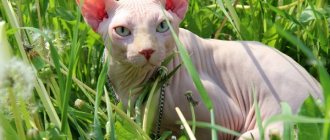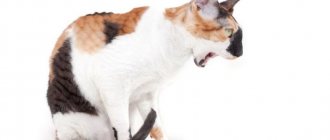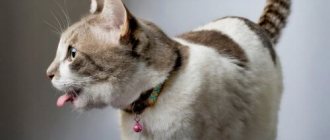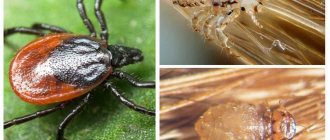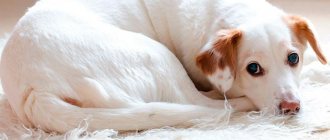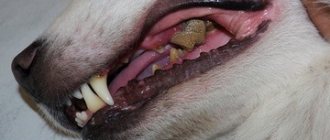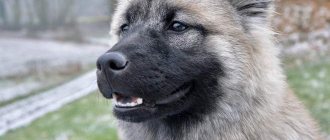Features of the structure of the Yorkie's jaw
By the end of the development of the skull, the Yorkie should have 42 teeth: 20 in the upper jaw, 22 in the lower. Yorkie teeth classification:
- incisors;
- fangs;
- premolars;
- molars.
If a dog is missing at least 1 tooth, you can forget about a show career. A professional judge cannot give preference to a dog with an incomplete set.
Features of the jaw structure
Yorkies are born toothless; around the second week of life, the first fangs appear. At one and a half months, the pet already has a milk dental kit.
Yorkshire Terrier with beautiful teeth
The standard teeth for a puppy are 28 units, after 3 months of age they begin to be replaced by molars. Loss begins with the incisors and canines, and the chewing ones grow last. At this time, the small animal begins to actively gnaw everything due to severe itching of the gums.
By 8 months, 42 permanent teeth grow in place of the first teeth. These include incisors, canines, premolars and molars. To speed up the changing process, you need to let your puppy try hard treats and sticks on his teeth.
For your information! Dogs have 26 chewing premolars and molars, which are the last ones to grow.
Basic questions about changing teeth
Sometimes the molars grow next to the baby teeth, so you need to make sure that they fall out over time. A dog with two rows of teeth has a funny face.
The owner may not notice how many teeth the Yorkshire Terrier loses. Puppies often swallow small teeth; they get lost on the floor or on the street during walks.
Food gets into the empty hole in the gum and rots, and the dog’s mouth smells unpleasant.
Diagram of the arrangement of teeth in a Yorkie's mouth
Bite
The normal bite of a Yorkie is a scissor bite. The following are considered deviations from the breed standard:
- snack (progenia);
- undershot (prognathia);
- direct jaw bite.
Some diseases, partly hereditary, lead to improper formation of the lower part of the skull. If they are detected in time, the dog's bite can be saved.
How often to brush your Yorkie's teeth
Yorkie's baby teeth are brushed 3 times a week, and permanent teeth every day. To clean, use dog toothpaste and a short-bristled brush. You can use a light solution of baking soda.
Note! To self-clean the enamel, pets are allowed to chew on young carrots, dried offal, and pumpkin.
Cleaning a small dog's incisors
When does a Yorkie change teeth?
All Yorkshire terriers change milk cycles at approximately the same time. By this sign you can even determine the age of the dog. The dog is born completely toothless. By 1-1.5 months the mammary row begins to emerge, by 4 months the molar row breaks through, and by 8 months a complete set is formed.
| Age: | Condition of the oral cavity: |
| up to 3-4 weeks | no teeth |
| older than 3-4 weeks | 2 milk fangs |
| 4-5 weeks | incisors and premolars |
| 3-5 months | first indigenous |
| 6-7 months | completion of the formation of the root series |
It is considered normal if the mammary row has not completely changed to the primary row before 8 months. If the 8th month has passed, and the teeth are not all molar, the Yorkie needs to be shown to the veterinarian.
Changing teeth
At this age, the replacement of “milk teeth” with permanent molars usually occurs. The process must be kept under control, because often the dog has problems caused by improper eruption of new incisors and fangs.
When teeth change, it is additionally necessary to take care of the pet’s proper nutrition: pre-grind all foods and completely exclude solid foods from the diet.
First, the incisors fall out, which dogs usually swallow along with food. With fangs the situation is somewhat different.
Sometimes even by eight months the teeth do not fall out, remaining baby teeth. In this case, you should seek advice from an experienced veterinarian, who will most likely remove the fangs so that they do not interfere with the correct bite.
It is difficult to say how long it will take for a Yorkie to change teeth, because it directly depends on the physiological characteristics of the animal’s body.
If there are no problems, new teeth are finally formed by the age of eight months - there are 42 of them (molars and premolars are added to the incisors with canines).
Common problems
The Yorkshire Terrier is a dog with dental problems, so a lot of difficulties arise. Let's try to understand the reasons that lead to jaw diseases:
- Poor nutrition. Lack of calcium and other mineral supplements negatively affects the development of the baby's jaws. If you feed your pet dry food, then you should look for an option with a large number of additives. And if you feed natural food, then consult a veterinarian about mineral feeding.
- Traumatic games. A baby's gums can be damaged by sharply tugging on a toy that is in his mouth. Be careful with fun.
- Genetics. Before purchasing a puppy, always examine the mother and father. There is almost a 100% chance of a puppy being born with minor jaw defects, if the parents have any.
- Soft food. Choose food that puts stress on the jaws. Active jaw work stimulates the replacement and strengthening of teeth. Drying is preferable in this regard.
We have sorted out the reasons that can lead to improper formation of fangs, now let’s move on to pressing problems.
Possible problems
A complete set of teeth is one of the main indicators of the health of a Yorkshire Terrier; many things depend on their condition, for example, the functioning of the gastrointestinal tract. If the dog is absolutely healthy, eats well and properly, then the teeth change in a timely manner and without any problems.
Of course, during the change process, the Yorkshire Terrier may feel unwell, be lethargic, drowsy, and refuse to eat. There may even be an increase in temperature. But there is nothing to worry about - these are side effects of a natural process. After its completion, the animal’s physical condition will return to normal.
Changing teeth does not always go smoothly. Yorkshire Terrier dogs often have problems in this regard. Let's consider what troubles the owner of a Yorkie can expect.
Sometimes milk teeth do not fall out in time and molars grow nearby. This results in the dog having two rows of teeth. As a result, jaws, gums, and tongue may be injured. Late shifts can also lead to bite problems. To avoid such complications, it is necessary to contact a veterinarian dentist in time to remove excess teeth.
Don't worry - this is a fairly simple operation, which is performed under local or general anesthesia, depending on the characteristics of the dog's body. To find out if the animal has any contraindications, you need to pass all the required tests and be examined by a doctor.
If problems with replacement teeth in an animal depend on genetic predisposition, then the future of the dentition is entirely in the hands of the owner.
In the absence of proper care, plaque forms on the Yorkshire Terrier's teeth, which gradually turns into tartar. Bad breath is not the only problem that occurs due to tartar. Inflammation of the dog’s oral cavity begins due to the work of bacteria and fungi. If your pet does not receive timely treatment, he may lose his teeth.
Delayed tooth change
Dwarf dog breeds face a problem when the root row has already erupted, but the milk row has not yet fallen out. This is caused by the incorrect location of the rudiment, and to it – the miniature size of the jaws.
A delay in the change from the deciduous row to the molar row leads to polyodontia, and in advanced cases to malocclusion. The disease is fraught with consequences: ingrown fangs injure the dog’s oral cavity, leading to the formation of ulcers and severe pain.
Fact: Dogs weighing more than 2.5 kg are less likely to suffer from polyodontia.
Changing baby teeth
After four months, the baby Yorkie begins to lose its baby teeth. The incisors change first, then the canines. Incisors usually fall out unnoticed. Changing canines is a more complex process.
Requires utmost attention. The owner should be aware of how many molars an eight-month-old Yorkie should have.
If the fangs have not fallen out by the end of the 7th month, you should immediately contact a veterinarian.
Permanent teeth grow through a canal formed in place of fallen milk teeth.
Malocclusion
A non-standard bite develops during the period of change from the deciduous to the molar. The main reason is a lack of calcium, as well as soft food, which poorly develops the chewing muscles.
How to correct an overbite in a Yorkie
Malocclusion in dogs is treated in the same way as in humans. Special staples, braces, and mouth guards are used. Let's say right away: the pleasure is not cheap. Devices for correcting malocclusion are divided into:
- removable:
- non-removable.
Mouth guards are new in the field of veterinary orthodontics. They are removable and change every couple of weeks. To install them, a one-time anesthesia is used to make an impression of the dog’s jaws. Afterwards, acrylic mouth guards are issued, which are worn for as long as possible. It is permissible to take them off while eating, playing, or walking.
Braces, on the other hand, can only be removed and put on by a veterinarian. Braces have a number of contraindications, such as: ulcers, periodontitis, allergies, etc. Plus, you need very careful care of the oral cavity while wearing braces.
Types of malocclusion
If the change of teeth in a Yorkie is not complete, the jaw may become deformed, the incisors and canines will grow in the wrong direction. Ideally, all breeds should have a scissor bite. In this case, the lower canines, when the jaws close, are located between the last incisor and the upper canine.
Correct scissor bite in a dog
When a Yorkie's teeth fall out with a long delay or when problems occur, the bite deteriorates. There are several types of malocclusion.
- The dog may have a snack. This is when the lower jaw protrudes significantly forward compared to the lower jaw. The problem is treated by removing some premolars;
- with underbite there is a large gap of more than 3 mm between the closed jaws. Visual description of underbite - the lower part of the mouth is shorter than the upper;
- There are pathologies of the jaw - too narrow or short. In a deformed row, the teeth are fanned out or layered on top of each other.
Important! With any type of malocclusion, the animal will subsequently have problems with roots and chewing food. The young dog needs to be shown to the doctor so that he can help correct the dentition. Sometimes permanent canines and molars have to be pulled out to straighten the jaw.
Care
Get your puppy used to brushing his teeth from a young age. Train him to show his fangs and not be afraid, but do not put your fingers in the gums until the baby fangs appear.
- Buy a brush for small dogs (or a brush for small children) and a special paste at the pet store.
- Apply a small amount of paste to the brush.
- Calmly and gently begin brushing a couple of teeth. If you have trained your Yorkie well, he will not resist the procedure.
- To make cleaning enjoyable and beneficial for your pet, treat him with a small treat at the end of the procedure.
Important: do not use pastes on people. York could accidentally ingest it and become poisoned.
Changing baby teeth in a Yorkie
The process of replacing baby teeth with permanent teeth in Yorkshire Terrier puppies occurs at the age of four to five months.
Yorkshire breeders must closely monitor the health and behavior of the pet, examine the dog’s mouth daily, monitoring the physiological process. All dogs, regardless of breed, must have 42 permanent teeth, which are divided into premolars, molars, incisors, and canines. Yorkie babies are born completely toothless. Yorkie babies begin to erupt their first milk teeth 10-12 days after birth. Their total number should be 28 pieces. First, two canines appear on each jaw, then incisors and premolars. The first tooth should be missing in primary premolars. Yorkshire terriers' teeth are one of the breed's most vulnerable areas, so owners should remember to brush their Yorkie's teeth and regularly examine the dog's oral cavity. When planning a show career, owners must take into account that malocclusion, the absence of one tooth, and poor condition of the dog’s oral cavity are considered disqualifying signs.
Replacing baby teeth is a very painful, unpleasant physiological process. Kids have sore gums, dogs chew on everything that interests them. To keep your personal belongings, pieces of furniture, and walls safe and sound, purchase as many different toys for your dog as possible, buy toys at a pet store. You shouldn’t scold your pet for damaging things, just remove from view the things that most attract the baby. Let the dog know that you are unhappy with this behavior, interest the pet in more interesting entertainment, praise the puppy for correct behavior in a gentle tone or with a treat.
Changing baby teeth
First, the primary incisors are replaced, then the canines. Don't worry if your puppy swallows some of his baby teeth. This will not cause any health problems. During tooth replacement, an unpleasant odor may emanate from the mouth, the puppy’s gums may bleed, and traces of blood can be found on toys, bedding, and personal belongings. Owners of mini Yorkshire terriers should be especially attentive to the process of replacing baby teeth.
Typically, the natural process of replacing teeth in dogs occurs without any problems. But due to the anatomical structure of the skull and small oral cavity, the process can be complicated. If your Yorkshire Terrier puppy's teeth have not fallen out before the age of eight months, you should take your pet to a veterinarian. Otherwise, the appearance of an incorrect bite cannot be avoided. Permanent incisors, premolars, and molars appear through the canal formed after the loss of milk teeth. In other words, permanent teeth grow in place of baby teeth. If the root of a baby tooth is not completely dissolved, the permanent tooth breaks through a new canal and, accordingly, grows in the wrong position. The dog develops an abnormal bite. According to the breed standard, the Yorkshire Terrier must have a scissor bite.
If, when examining your mouth, you notice growing teeth in two rows, or a baby tooth is loose, but does not fall out for a long period of time, surgical removal under general anesthesia, which will be carried out in a veterinary clinic, will help. If a baby tooth is loose but does not fall out, you can try to loosen it yourself. But this procedure must be done carefully, observing the rules of hygiene and sterility. After replacing milk, you can gradually accustom the dog to the necessary hygienic cleaning procedure.
Is it possible to replace brushing your Yorkie's mouth with treats?
Promotions of various dog treats will not leave anyone indifferent. They are said to completely clean the incisors and promote oral hygiene. This also applies to dry food. It is a mistake to believe that since dry food promotes jaw development, then the dog does not need anything else. This is only partly true, because no amount of treats or bones can replace brushing your teeth.
At least once every week or two, thoroughly clean your Yorkie's mouth. This will help avoid bad breath, tartar formation and yellow plaque. And for extra care, use vet-approved treats.
Side effects
Often, during the change of baby teeth, the Yorkshire Terrier emits an unpleasant odor. However, there should be no cause for concern. It’s just that two teeth take up one place, and pieces of food get stuck in the gaps formed - hence the characteristic smell from the mouth.
A similar problem can occur when the primary incisors do not fall out on time, and the permanent ones are already beginning to line up in the second row.
To correct the situation with an unpleasant “aroma”, daily brushing of new teeth and mandatory removal of milk teeth, which are in a loose state and prevent the little Yorkie from chewing food normally, will help.
- In rare cases, puppies may experience retention - an extremely unpleasant situation when there is free space in the place of the primary incisor or canine, but the molar does not break through. This usually occurs if the Yorkshire Terrier's dental root bud is positioned incorrectly or is missing.
It would be wise not to wait until the puppy’s already depressing situation changes for the better, but to seek help from a specialized clinic. But it is advisable to choose a trusted veterinary hospital for your pet, because retention can develop even after incorrect removal of baby teeth.



